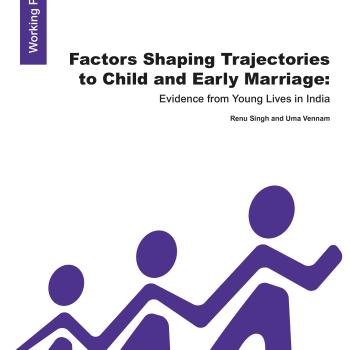
The 2011 Census in India reported that nearly 17 million children between the ages of 10 and 19 –6% of the age group – are married, with girls constituting the majority (76 per cent), although there has been a significant relative reduction in the marriage of girls under 14. The aim of this paper is to better understand the individual, household and community factors that explain the different pathways to marriage among Young Lives children, drawing upon both descriptive statistics from the household survey as well as in-depth qualitative research with the study children.
The paper finds that secondary education, not being involved in paid work at age 12, high aspirations among mothers and daughters towards completing higher education, and parental education levels are all factors that are associated with delaying child and early marriage. On the other hand, poverty, caste, and rural location emerge as factors that are drivers of teen marriage. Girls from the poorest wealth tercile were 2.4 times more likely to be married by 19 than girls from least-poor families and girls in rural areas 2.3 times more likely to be married than girls in urban areas. Patriarchy and gendered social norms remains one of the drivers of early marriage, and dowry was paid by all families with 40 per cent paying more than one lakh Rupees (100,000), leaving the girl’s family burdened with loans.
It is critical that stakeholders such as the Ministry of Women and Child Development work with statutory bodies such as the Integrated Child Protection Scheme to ensure detection and prompt referral of cases of girls who require care and protection. Together they must work towards implementing the 2013 National Strategy on the Prevention of Child Marriage. This will require close collaboration with Ministry of Health and Family Welfare, the Ministry of Labour and the Ministry of Human Resource Development and as well as with legal institutions such as Child Protection Committees and most importantly local communities. Unless a multi-pronged approach to address persisting practices such as dowry as well as gender norms that devalue girls are not addressed, girls from the poorest and socially disadvantaged households will continue to be left out of the development agenda and be prevented from attaining their full potential.

The 2011 Census in India reported that nearly 17 million children between the ages of 10 and 19 –6% of the age group – are married, with girls constituting the majority (76 per cent), although there has been a significant relative reduction in the marriage of girls under 14. The aim of this paper is to better understand the individual, household and community factors that explain the different pathways to marriage among Young Lives children, drawing upon both descriptive statistics from the household survey as well as in-depth qualitative research with the study children.
The paper finds that secondary education, not being involved in paid work at age 12, high aspirations among mothers and daughters towards completing higher education, and parental education levels are all factors that are associated with delaying child and early marriage. On the other hand, poverty, caste, and rural location emerge as factors that are drivers of teen marriage. Girls from the poorest wealth tercile were 2.4 times more likely to be married by 19 than girls from least-poor families and girls in rural areas 2.3 times more likely to be married than girls in urban areas. Patriarchy and gendered social norms remains one of the drivers of early marriage, and dowry was paid by all families with 40 per cent paying more than one lakh Rupees (100,000), leaving the girl’s family burdened with loans.
It is critical that stakeholders such as the Ministry of Women and Child Development work with statutory bodies such as the Integrated Child Protection Scheme to ensure detection and prompt referral of cases of girls who require care and protection. Together they must work towards implementing the 2013 National Strategy on the Prevention of Child Marriage. This will require close collaboration with Ministry of Health and Family Welfare, the Ministry of Labour and the Ministry of Human Resource Development and as well as with legal institutions such as Child Protection Committees and most importantly local communities. Unless a multi-pronged approach to address persisting practices such as dowry as well as gender norms that devalue girls are not addressed, girls from the poorest and socially disadvantaged households will continue to be left out of the development agenda and be prevented from attaining their full potential.

